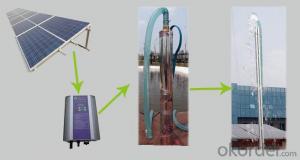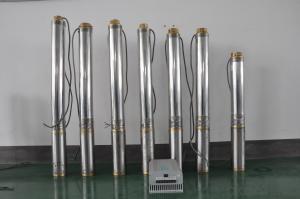Solar Water Pumping Solar Power Pumps Submersible Pump
- Loading Port:
- Shanghai
- Payment Terms:
- TT OR LC
- Min Order Qty:
- 1 set
- Supply Capability:
- 1000 set/month
OKorder Service Pledge
OKorder Financial Service
You Might Also Like
Solar Water Pumping Solar Power Pumps Submersible Pump
DC solar water pumping system consists of the motor, pump, controller, solar array and some other accessories, such as water level sensor, float switch, etc. Considered that storing water is more efficient than storing electricity, the system is designed to directly drive the pump without battery which can reduce the construction and operating cost and routine maintenance effectively.The PV array consists of multiple solar panels connected in series/parallel, which can supply the whole system as power source by converting the absorbed solar radiation energy to the electrical energy. The pump driven by a brushless DC permanent magnet motor draws water from deep-well or river. The pumped water is then fed into reservoir or water tank, or connected to the irrigation system or fountain system directly.
Advanced Technology
Applications Innovation
The efficiency of DC brushless permanent magnet motor has been increased up to 25% in comparison with traditional asynchronous motor.
Technology Innovation
Stator and rotor are sealed by environment friendly casting resin.Motor insulation resistance can be hold higher than 300MΩfor more than 10 years, which consumedly increased the security and reliability of the submersible motor.
Structure Innovation
Casting resign technology processed stator and rotor as well as the water lubricated bearing make the submersible pump environment friendly.
Feature
High Efficiency & High Reliability
DC Brushless Permanent Magnet Motor
Minimum Maintenance, long Service Life
Environment Friendly Materials, Lubricated Without Oil
Application
Village or Family Water Supply
Animal Drinking Water & Livestock Watering
Garden/Courtyard Irrigation
Swimming Pool
Water Supply for Bivouac or Camping Car
Water Supply for Remote Area
Automatic Control
Operate Automatically, No Need Watching
Maximum Power Point Tracking (MPPT)
Dry-run Protection
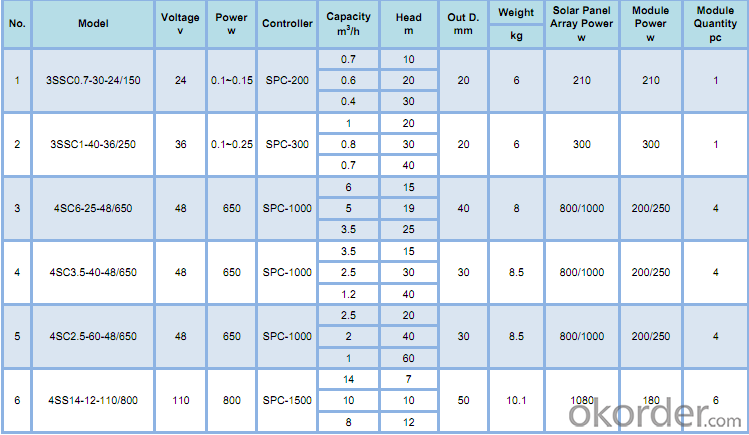
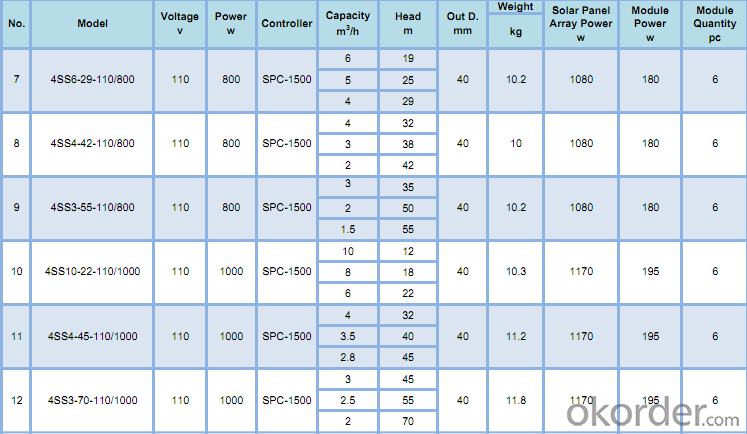
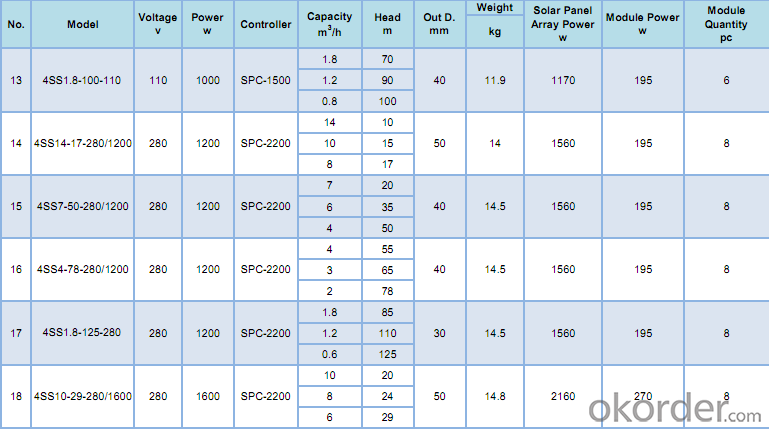
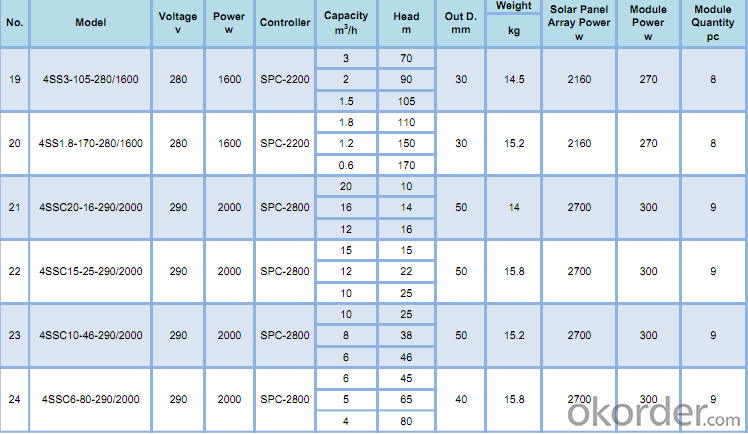

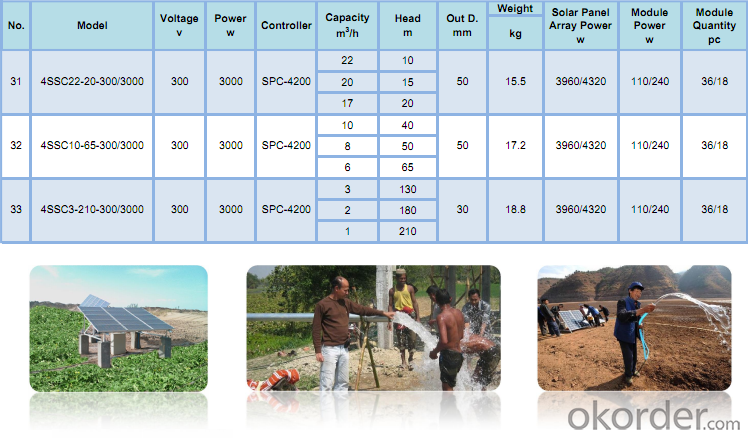
- Q:Can a solar pump be used for water supply in off-grid agricultural fields?
- Certainly, water supply in off-grid agricultural fields can be achieved using a solar pump. Solar pumps are designed specifically to utilize solar energy, making them an ideal solution for remote locations with limited or no access to grid electricity. These pumps use photovoltaic (PV) panels to convert sunlight into electricity, which powers the motor to draw water from various sources and deliver it to the fields for irrigation. The use of solar pumps in off-grid agricultural fields provides several advantages. Firstly, they are environmentally friendly, as they do not emit harmful substances or contribute to greenhouse gas emissions like traditional diesel or petrol pumps. This makes solar pumps a sustainable and clean solution that aligns with eco-friendly farming principles. Secondly, solar pumps offer a reliable and consistent water supply. With sufficient sunlight, these pumps can operate all day, ensuring a continuous flow of water to the fields. Additionally, solar pumps often come equipped with battery storage systems, enabling them to operate even during cloudy days or at night when solar energy is unavailable. This ensures uninterrupted water supply, enhancing crop growth and yield. Furthermore, solar pumps are cost-effective in the long term. Although the initial investment may be higher compared to conventional pumps, solar pumps have lower operational and maintenance costs. They do not require fuel or electricity, reducing ongoing expenses. Additionally, solar pumps have a longer lifespan and require minimal maintenance, resulting in reduced downtime and repair costs. Lastly, solar pumps promote energy independence and self-sufficiency. By harnessing the sun's power, farmers can rely on a renewable energy source and reduce their reliance on external fuel or electricity providers. This allows for greater autonomy and control over water supply, enhancing the resilience of off-grid agricultural systems. In conclusion, solar pumps are an excellent choice for water supply in off-grid agricultural fields. They offer a sustainable, reliable, cost-effective, and independent solution that can significantly benefit farmers and contribute to sustainable agriculture practices.
- Q:Can solar pumps be used for water supply in agricultural fields or farms?
- Yes, solar pumps can be used for water supply in agricultural fields or farms. These pumps utilize solar energy to power their operation, making them an environmentally friendly and cost-effective solution for pumping water in remote locations. They can help farmers irrigate their crops, provide water for livestock, and contribute to sustainable farming practices.
- Q:Can a solar pump be used for fountain or waterfall features?
- Yes, a solar pump can be used for fountain or waterfall features. Solar pumps are designed to be powered by solar energy, which means they do not require any electricity from the grid. This makes them an ideal choice for outdoor water features such as fountains or waterfalls, where running electricity can be difficult or expensive. Solar pumps are typically easy to install and operate, and they can provide a constant flow of water to create beautiful and soothing water displays. Additionally, using a solar pump for a fountain or waterfall is environmentally friendly since it utilizes renewable energy and reduces reliance on traditional electricity sources.
- Q:How does a solar pump handle water with high levels of organic matter?
- A solar pump can handle water with high levels of organic matter by utilizing a filtration system. The pump is equipped with filters that effectively remove or reduce the organic matter present in the water. This allows the pump to operate efficiently and ensures the water being pumped is free from any potential clogging or damage caused by the organic matter.
- Q:Is it possible to retrofit an existing pump system with solar power?
- Retrofitting an existing pump system with solar power is indeed a possibility. The process involves integrating solar panels and a solar power converter into the system that already exists. To maximize sunlight exposure, the solar panels would typically be installed on the roof or in a nearby area. By connecting the solar power converter to the existing pump system, it becomes possible for the system to draw power from the solar panels. As a result, the pump system can function independently of the electrical grid, potentially eliminating the need for traditional electricity altogether. Retrofitting with solar power offers numerous benefits, including reduced operating costs, lower carbon emissions, and increased energy self-sufficiency. However, it is crucial to consider the specific requirements of the pump system and ensure that the solar power capacity meets its needs.
- Q:How does the size of the solar pump motor affect its performance?
- The size of the solar pump motor has a significant impact on its performance. The motor size directly affects the pump's power output and efficiency. A larger motor generally means a higher power output, which results in a greater water flow and higher pressure. This is particularly important for applications that require pumping water over long distances or to higher elevations. A larger motor can generate more force, enabling it to overcome friction and deliver water with greater speed and force. Moreover, a larger motor can handle a higher workload and operate for longer periods without overheating. It can handle larger volumes of water and work more efficiently, reducing energy consumption and increasing the overall effectiveness of the solar pump system. On the other hand, a smaller motor may have limitations in terms of power output and efficiency. It may struggle to provide sufficient water flow and pressure, especially for demanding applications. A smaller motor might also have a lower workload capacity, leading to more frequent breakdowns and reduced longevity. It is crucial to choose a motor size that aligns with the intended application and the specific requirements of the solar pump system. Factors such as the desired water flow rate, required pressure, and the distance and elevation the water needs to be pumped are all crucial considerations in determining the appropriate motor size. In summary, the size of the solar pump motor directly influences its performance. A larger motor can provide higher power output, greater water flow, and better efficiency, while a smaller motor may have limitations in these areas. Selecting the right motor size is fundamental to ensure optimal performance and reliability of the solar pump system.
- Q:How does a solar pump handle water with high levels of heavy metals or radioactive materials?
- A solar pump, by itself, does not have a mechanism to handle water with high levels of heavy metals or radioactive materials. However, additional water treatment systems, such as filtration, chemical treatment, or reverse osmosis, can be integrated with the solar pump to address the presence of these contaminants and ensure the water is safe for use.
- Q:How much power does a solar pump require?
- The power required for a solar pump depends on various factors such as the desired flow rate, head pressure, efficiency of the pump, and available sunlight. Generally, a solar pump can range from a few watts to several kilowatts.
- Q:How does the size of the pump motor affect the performance of a solar pump?
- Determining the performance of a solar pump heavily relies on the size of the pump motor. The flow rate, pressure, and overall efficiency of the pump are directly influenced by the motor size. When the pump motor is larger, it enables a higher flow rate, resulting in the ability to pump more water within a given time period. This is particularly important in scenarios where a substantial amount of water needs to be transported, such as in agricultural irrigation or large-scale water supply systems. A higher flow rate guarantees the effective and efficient delivery of the desired volume of water. Moreover, the size of the pump motor impacts the pump's ability to generate pressure. A larger motor is capable of creating higher pressure, which becomes necessary when pumping water to elevated areas or overcoming resistance in an extensive pipe network. The increased pressure ensures that water reaches its intended destination with sufficient force and can be evenly distributed across the irrigation system or other applications. Furthermore, a larger motor often leads to improved efficiency. With a more powerful motor, the pump requires less time to complete its pumping cycle, resulting in reduced energy consumption. This not only saves costs but also promotes a more sustainable utilization of solar energy. It is important to note that while a larger motor generally offers better performance, it also demands more energy to operate. Therefore, it is crucial to find a balance between motor size and energy availability. If the solar array providing power to the pump cannot generate enough electricity to operate a larger motor, it may be necessary to opt for a smaller motor that can still meet the required performance levels without exceeding the available energy supply. To conclude, the size of the pump motor significantly impacts the performance of a solar pump. A larger motor allows for higher flow rates, increased pressure, and improved efficiency. However, it is essential to consider the available energy supply when selecting the motor size to ensure optimal performance and energy utilization.
- Q:How do solar pumps handle fluctuations in voltage or power supply?
- Solar pumps are equipped with built-in voltage regulators and control mechanisms that help them handle fluctuations in voltage or power supply. These devices monitor the incoming voltage and adjust the pump's operation accordingly, ensuring that it continues to function optimally even during variations in power supply. Additionally, solar pumps often have backup power sources, such as battery banks, that store excess energy generated during sunny periods. This stored energy can be utilized during low sunlight or power supply fluctuations, maintaining a consistent and reliable water pumping system.
1. Manufacturer Overview |
|
|---|---|
| Location | |
| Year Established | |
| Annual Output Value | |
| Main Markets | |
| Company Certifications | |
2. Manufacturer Certificates |
|
|---|---|
| a) Certification Name | |
| Range | |
| Reference | |
| Validity Period | |
3. Manufacturer Capability |
|
|---|---|
| a)Trade Capacity | |
| Nearest Port | |
| Export Percentage | |
| No.of Employees in Trade Department | |
| Language Spoken: | |
| b)Factory Information | |
| Factory Size: | |
| No. of Production Lines | |
| Contract Manufacturing | |
| Product Price Range | |
Send your message to us
Solar Water Pumping Solar Power Pumps Submersible Pump
- Loading Port:
- Shanghai
- Payment Terms:
- TT OR LC
- Min Order Qty:
- 1 set
- Supply Capability:
- 1000 set/month
OKorder Service Pledge
OKorder Financial Service
Similar products
New products
Hot products
Hot Searches
Related keywords
